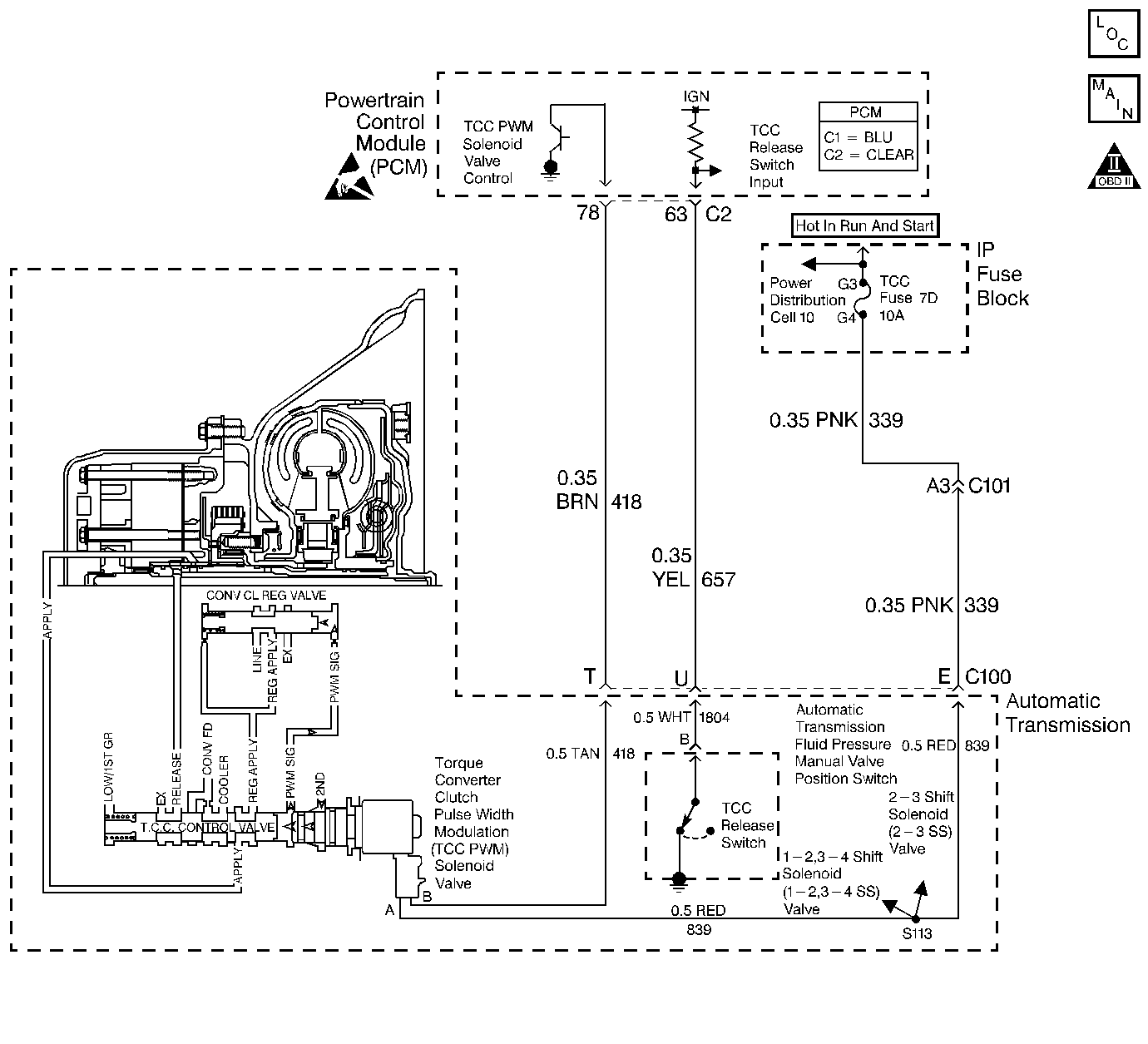
Circuit Description
The PCM controls the torque converter clutch pulse width modulation (TCC PWM) solenoid valve. The solenoid controls the hydraulic fluid for TCC apply and release. When the TCC is fully applied, the engine is coupled directly to the transmission through the TCC.
The TCC used is the electronically controlled capacity clutch (ECCC). The ECCC allows the TCC to slip a small amount without excessive wear. This allows smooth application and release of the TCC. When the TCC PWM solenoid valve engages the TCC, TCC slip speed is maintained at approximately 20 RPM.
If the PCM detects high torque converter slip when the TCC is commanded ON, then DTC P0741 sets. DTC P0741 is a Type B DTC.
Conditions for Running the DTC
| • | No TP sensor DTCs P0121, P0122 or P0123 are set. |
| • | No VSS DTCs P0502 or P0503 are set. |
| • | No A/T ISS sensor DTCs P0716 or P0717 are set. |
| • | No TCC stuck ON DTC P0742 is set. |
| • | No TFP manual valve position switch DTC P1810 is set. |
| • | No TCC PWM solenoid valve DTC P1860 is set. |
| • | No TCC release switch DTC P1887 is set. |
| • | The transmission gear range is D4, D3 or D2. |
| • | The time since the last gear range change is greater than 3 seconds. |
| • | The transmission fluid temperature is greater than 20°C (68°F). |
| • | The engine speed is greater than 500 RPM for 5 seconds and not in fuel shut off. |
| • | The TP angle is 4-35%. |
| • | The TCC PWM solenoid valve is commanded ON for more than 0.5 seconds. |
| • | The TCC is at maximum apply pressure. |
Conditions for Setting the DTC
The TCC slip speed is greater than 180 RPM twice for 7 seconds each.
Action Taken When the DTC Sets
| • | The PCM illuminates the malfunction indicator lamp (MIL) during the second consecutive trip in which the conditions for setting the DTC are met. |
| • | The PCM inhibits TCC. |
| • | The PCM inhibits 4th gear if the transmission is in Hot Mode. |
| • | The PCM freezes shift adapts. |
| • | The PCM stores DTC P0741 in PCM history. |
Conditions for Clearing the MIL/DTC
| • | The PCM turns OFF the MIL during the third consecutive trip in which the diagnostic test runs and passes. |
| • | A scan tool clears the DTC from the PCM history. |
| • | The PCM clears the DTC from the PCM history if the vehicle completes 40 consecutive warm-up cycles without an emission related diagnostic fault occurring. |
| • | The PCM cancels the DTC default actions when the fault no longer exists and the ignition switch is OFF long enough in order to power down the PCM. |
Diagnostic Aids
| • | Inspect the transmission fluid level. |
| • | The transmission may be in Hot Mode. Inspect the transmission fluid lines to the radiator. The lines may be pinched, plugged or twisted. |
Test Description
The numbers below refer to the step numbers on the diagnostic table.
Step | Action | Value(s) | Yes | No | ||||||||||
|---|---|---|---|---|---|---|---|---|---|---|---|---|---|---|
1 | Was the Powertrain On-Board Diagnostic (OBD) System Check performed? | -- | Go to Powertrain On Board Diagnostic (OBD) System Check in Engine Controls | |||||||||||
2 | Was the transmission fluid checking procedure performed? | -- | Go to Transmission Fluid Check | |||||||||||
3 |
Important: Before clearing the DTCs, use the scan tool in order to record the Freeze Frame and Failure Records for reference. Using the Clear Info function will erase the stored Freeze Frame and Failure Records from the PCM. Is TCC release pressure present? | -- | ||||||||||||
4 |
Refer to Unit Repair.
Is the inspection or repair complete? | -- | -- | |||||||||||
Is the slip speed within the specified value? | -50 RPM to +50 RPM | Go to Diagnostic Aids | ||||||||||||
6 |
Refer to Unit Repair.
Is the inspection or repair complete? | -- | -- | |||||||||||
7 | Perform the following procedure in order to verify the repair:
Has the test run and passed? | -- | System OK |
